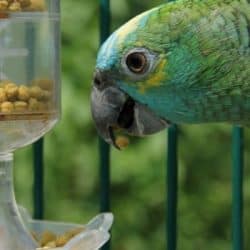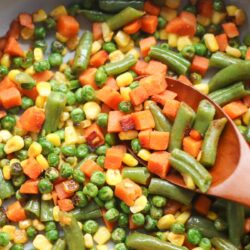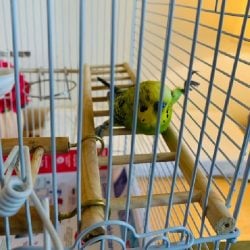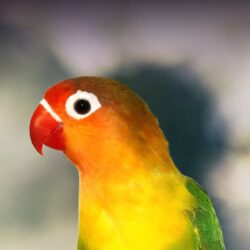
Poicephalus – 9 African Parrot Species not Ending in Grey
Last Updated on by Mitch Rezman
Editor’s note: this post was written almost 4 years ago to the day. I’m using it in an answer on Quora regarding how to quiet birds.
There was no way to have predicted at the writing of this article that we would become companion to a Senegal (poicephalus) parrot. The universe is too complicated to be arbitrary.
Thank you to Ann K. one of our Facebook fans. She’s planning on getting a Cape Parrot soon and was unable to find a lot of information on this particular species.
She requested that we provide some information on this little-known type of bird. So we will start with the Cape Parrot but we are going to cover all the Poicephalus Parrots species.
Poicephalus Parrots are African Parrots including – Senegal Parrots, Meyer’s Parrots, Jardine’s Parrots, Rueppell’s Parrots, Red-bellied Parrots, Yellow-faced Parrots, Brown-headed Parrots, Niam Niam AND Cape Parrots (South African Cape Parrots, Brown-necked Parrots & Grey-headed Parrots – technically speaking)
Because we’re focused on Poicephalus Parrots, the other African bird species including Vasa Parrots, Lovebirds and African Ringnecks will be covered in other articles.
According to Thor’s Cape Parrot Site, “In captivity Cape Parrots (aka Levaillant’s Parrot) are often referred to as the ‘gentle giants’……” They are the largest of the Poicephalus family and have a relatively large head and beak.
They’re typically 13 to 14 inches long and weigh anywhere from approximately 200 – 400+ grams with most Cape Parrots being in the 300 g weight range. They can live 30 years but usually live 15 to 20 and sexually mature in 3 to 5 years.
They’re shy birds and don’t demand a lot of attention reaching independence once hitting sexual maturity. They are playful and full of energy but not necessarily great talkers according to Susanclubb.com.
Cape Parrots come in three flavors, South African Cape Parrots, Brown-necked Parrots & Grey-headed Parrots – South African Cape Parrots are the species primarily found here in the US as pets.
Senegal Parrots are medium-sized parrots about 10 inches long, and weigh about 100 – 170 g ( between 4 and 6 ounces) and can live up to 50 years in captivity. They make great pets, are a lot of fun and actually a lot quieter than other types of parrots. In a family situation, it’s important that all the family members socialize with the young bird on a regular basis otherwise Senegal Parrots can become a “one person” bird.
Although Senegal Parrots are not sexually dimorphic, the C-shape of the chest is usually longer on the females and the green area generally extends over the chest down between the legs while male Senegal parrots generally have the green area that ends halfway or at the middle of the chest.
Usually a females beak as well as their head are a smidge smaller than the males and lastly male Senegal Parrots are usually although not always bigger than their female counterparts overall.
Meyer’s Parrots are felt by some to be the prettiest among the African Parrots with their iridescent turquoise feathers. They are fun, playful, love to swing and dangle and will lie on their back and do silly things with their feet while playing with toys.
They are a good choice for a family with children as they can maintain relationships with several people and they’re not necessarily biters
They are small, about 11 – 12 inches long and only weigh 90 – 130 g.
They’re notable for yellow markings on their wings and turquoise markings on their abdomen and rear end. They are not great talkers. It’s said that their voices are similar to those of Parakeets (Budgies).
Jardine’s Parrots make great pets too. Their bodies are bright green with red rings around the bottoms of the leg feathers.
They’re generally a darker green in color and a bit more robust in size than the other Poicephalus Parrots. They are very sweet natured and intermingle well with the entire family.
They are one of the largest of the Poicephalus species measuring an average of 11 inches long and weighing up to 8 ounces.
They make good pets if you live in an apartment or condo although they can get vocal early in the morning and the early evening.
Jardine’s have a lot of energy and need a lot of exercise, mental stimulation in a roomy cage.
They generally live to be about 30 years old but there are records of Jardine’s living past 60. Rueppell’s Parrots (not to be confused with Rueppell’s Vultures know to fly at altitudes exceeding 35,000 feet) are a small species and as adults they are sexually dimorphic.
Adult female Rueppell’s have blue feathers along the lower portion of their back and rear end whereas the male Rueppell’s lose the blue feathers.
Both male and female Rueppell parrots have deep yellow marking on the epaulets of their wings. The average Rueppell’s is about 9 inches long and weighs between 120 and 160 g.
Red-bellied Parrots are small like Rueppell’s Parrots. They are only about 9 inches long and are sexually dimorphic with the male Red-bellied Parrots having a bright orange lower chest and tummy while the adult females are green on the lower frontal area.
Red-bellied Parrots are probably the best talkers of the Poicephalus family because they speak clearly and with real understanding and in many cases exhibit more than a single voice.
Some owners say that they can call people by name and can speak in the voices of the people are that are speaking to them. If you’re looking for a small bird that has the ability to talk, Red-bellied parrots maybe the choice for you as a pet. Red-bellied males have an orange tummy, female’s tummies are green.
Yellow-front Poicephalus aka Yellow-faced Parrots are not to be confused with Yellow Front Amazons of South America are medium-size – about 11 inches long. They’re loud with shrill whistles and screeches.
They have a shape similar to Jardine Parrots but their green is a paler green and they have no red nor orange/red markings on their body or head.
As its name suggests they’re notable for a big area of yellow around their face extending down onto the crown and around their eyes. Don’t expect to find them as pets anywhere because they’re not found in captivity – but reside exclusively in the African country of Ethiopia.
Brown-headed Parrots are popular as pets and make a good choice if you live in a condo or apartment because they’re quiet and have a very nice temperament.
Similar to Senegal parrots but lacking in the bright yellow or orange belly and have a whitish beak whereas Senegal’s beaks are mostly all dark gray or almost black. They are small – about the same size as a Senegal or Meyers about 9 inches long and weigh about 120 g.
They’re a bit bigger than Cockatiels and much chunkier. Although they look very similar to Senegal parrots they are almost identical to the Niam Niam Parrots (top). They can learn to speak a few words and phrases but many do not, so if you are looking for bird who can definitely speak the Brown-headed Parrot would not be the choice.
https://www.youtube.com/watch?v=QCxNFRSvVe4
Overall we like to recommend as large a bird cage as possible for most parrots but it’s our understanding that for some of the smaller African Parrots, like the Brown-headed Parrot, an 18″ to 20″ wide and a 20″ to 24″ tall bird cage works well.
Niam Niam parrots (not known in captivity) are about 10 inches long with both male and female adults having brown heads and necks with a bit of olive/yellow, olive/brown around their throats and breasts, silver gray around their ears and olive/brown tipped tails with a dull green.
The red under its wing coverts distinguishes it from the Brown headed parrot’s yellow under their wing coverts. They have very sharp voices which can be heard from far away and become even more high-pitched when sounding a danger alert.
written by Mitch Rezman CMO Windy City Parrot, Inc
Simply Everything for Exotic Birds – Since 1993
Author Profile
Latest entries
 Feeding Exotic BirdsDecember 29, 2025How to Switch or Convert Your Bird From Seeds to Pellets: Real-Life Case Studies and Practical Guidance
Feeding Exotic BirdsDecember 29, 2025How to Switch or Convert Your Bird From Seeds to Pellets: Real-Life Case Studies and Practical Guidance Feeding Exotic BirdsDecember 16, 2025A Practical, Budget-Smart Guide to Feeding Birds Well
Feeding Exotic BirdsDecember 16, 2025A Practical, Budget-Smart Guide to Feeding Birds Well Bird EnviornmentsDecember 7, 2025Understanding Budgie Cage Bar Orientation: Myths, Realities & Practical Solutions for Vertical-Bar Bird Cages
Bird EnviornmentsDecember 7, 2025Understanding Budgie Cage Bar Orientation: Myths, Realities & Practical Solutions for Vertical-Bar Bird Cages Feeding Exotic BirdsDecember 5, 2025How Dr. T.J. Lafeber Rewrote the Future of Pet Bird Nutrition
Feeding Exotic BirdsDecember 5, 2025How Dr. T.J. Lafeber Rewrote the Future of Pet Bird Nutrition


